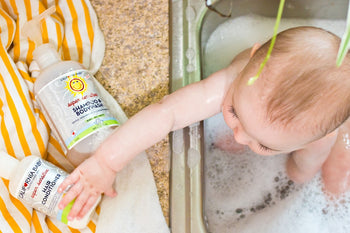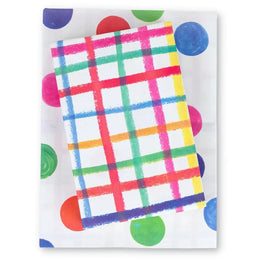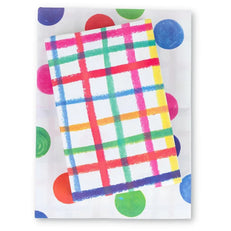Baby diaper rash is one of the most common skin conditions parents must learn to manage as long as their little one is in diapers. It’s uncomfortable for the baby and anxiety-inducing for the parents. But when the problem goes from pesky to painful, caregivers are left questioning whether rash cream or ointment is the better option to help it heal.
A rash cream might cut it if your baby diaper rash is mild. However, when their cute little bum is really bright red and sore—or prone to a recurring rash—you’re going to want the moisture-trapping barrier strength of an ointment formulated without common irritants that can aggravate the rash.
This article covers:
- The difference between rash cream and ointment
- Why ointments are best for treating diaper rash
- Common irritants in conventional creams that can make diaper rash worse
- Our USDA-certified 100% biobased diaper rash ointment
- Key ingredients in California Baby’s diaper rash ointment
- Lavender-scented or fragrance-free: which scent suits your baby?
- When and how to use diaper rash ointment
- The bottom line
What’s the difference between ointments, creams and lotions?
The primary difference between the three topicals is their water-to-oil ratio, which plays a big role in the texture, absorption, spreadability and protective power of each formulation. The short story is that ointments are oil-based while creams and lotions are water-based. Creams are thicker than lotions and ointments are thicker than creams. Each has its place in your baby skincare kit, but an ointment is going to be your heaviest hitter against baby diaper rash and more effective than a rash cream.
Lotions contain more water than oil
On the water-to-oil spectrum, lotions swing solidly on the side of H2O. They’re typically thinner than creams and formulated with lighter-weight ingredients, like aloe vera and extracts. Of the three consistencies, lotions are the easiest to spread and absorb the most quickly without leaving behind a greasy residue or sticky feeling. This makes them great for everyday use to keep newborn skin hydrated, but it also means they’re not thick enough to create the protective barrier needed to prevent or treat diaper rash.
Creams are generally equal parts oil and water
Generally, creams are the middle-of-the-road option but they can contain more water than oil depending on the formulation. Creams are thicker than lotions and made with heavier ingredients. They still spread well over large surface areas but don’t absorb as quickly. Some rash creams are formulated with occlusives, like shea butter, that form a temporary film to help prevent moisture from escaping the skin.
Ointments are more oil than water
Ointments contain the most oil of the three consistencies and therefore stay on top of the skin longer and absorb more slowly. This creates a stronger protective barrier against environmental elements like dry air, excess moisture or chafing diapers. Medicated skincare products typically come in ointment form because they stay on the skin longer. However, because they don’t spread as easily as creams or lotions, ointments are best for smaller surfaces, like the diaper area.
Why California Baby prefers ointment for baby diaper rash
The most common baby diaper rash is dermatitis — dry, red patches of irritated skin typically found in high-contact friction zones like the diaper area. In this case, keeping moisture trapped in the skin while creating a barrier between the skin and irritants like pee, poo and the diaper itself is critical to soothing discomfort and aiding the healing process. Even if the baby diaper rash you’re dealing with is fungal (hot to the touch, moist and in severe cases blistering), the thick, stay-put barrier of an ointment has better protective benefits that last longer than a thinner, fast-absorbing rash cream.
Of course, how effective either a rash cream or ointment is depends not only on the protective thickness of the formula but also on the raw ingredients used in it. Our famously gentle diaper rash ointment is water-free, making it ultra-concentrated and even more effective against diaper rash. But what makes it a fan-favorite among parents is that our 100% bio-based formula doesn’t contain the allergens, preservatives or petroleum contaminants that commonly irritate newborn’s sensitive skin and can actually make baby diaper rash worse.
Watch out for these common irritants in conventional creams that can make diaper rash worse
Infant’s thinner skin is already more vulnerable to absorbing ingredients applied topically. Severe diaper rash that damages or breaks open the skin can increase absorption even more. So it’s important to make sure harsh chemicals and irritants don’t come into contact with your baby’s sensitive areas via their diaper care products. We’ve sworn off these common irritants that pop up all too often in conventional rash creams and ointments.
Synthetic fragrance
Synthetic fragrances are on the top of the skin allergy list. That’s because they’re considered a trade secret by the FDA and therefore the “fragrance” or “perfume” on a label could mean a cocktail of literally any number of chemicals, allergens and synthetics that don’t have to be listed. If you don’t know what those ingredients are, you won’t know what your baby’s skin is reacting to.
Preservatives
The problem with preservatives in diaper rash creams is that they are often ingredients linked to skin irritation, like parabens and formaldehyde. Fighting inflamed, irritated skin with a skin irritant doesn’t bode well for healing baby diaper rash. And where there are preservatives, there is water in the formula—another ingredient that can make diaper rash worse since moisture creates the conditions for it to thrive.
Petroleum-based synthetics
Petroleum-based synthetics, including mineral oils, are a byproduct of the petroleum refining process and susceptible to contamination by known carcinogens. Baby care product labels don’t tell parents if contaminants have been properly removed from petroleum-based formulas, making them a risky gamble. Human health concerns aside, reliance on non-renewable petro-derived ingredients isn’t a viable longterm solution—for diaper rash or the planet.
Our diaper rash ointment is USDA-certified 100% bio-based
Certified 100% bio-based products are an easy way for parents to know if the product they’re putting on their newborn’s skin contains petroleum-derived synthetic ingredients. An independent lab tests the formula to identify the percentage of carbon that comes from plants and animals versus petroleum sources. Our diaper ointments are USDA-certified as 100% bio-based, meaning they contain no petrochemicals or petroleum-derived synthetics.

Key ingredients in California Baby’s diaper rash ointment
Most baby diaper rash creams are made with mineral oil or petrolatum (a.k.a petroleum jelly, like in Vaseline®) as the main occlusive, but not ours. California Baby’s diaper rash ointments are 100% bio-based, water-free and formulated without common allergens, preservatives or harsh chemicals—all culprits in aiding and abetting baby diaper rash. Rather than petroleum-derived synthetics, we use vitamin-grade zinc oxide and ultra-purified lanolin in a waterless formula.
Water-free
Formulating our diaper ointments without water allowed us to go preservative-free. Preservatives can be irritating to sensitive skin, especially sensitive skin already inflamed from a baby diaper rash. Plus, our waterless formula is also super-concentrated so a little goes a long way! You’ll get a lot of mileage out of one tube.
Vitamin-grade zinc oxide
Sturdy and with a waxy consistency, zinc oxide is the protective active in our formula that sits on top of the skin to create that much-needed barrier against wetness, bacteria and chafing to prevent diaper rash and aid its healing.
Ultra-purified lanolin
USP grade lanolin pressed from sheep’s wool is a natural and renewable alternative to petroleum synthetics. Like zinc, it has a wax-like structure that helps prevent transepidermal water loss, or moisture evaporating from the skin. Lanolin is common in rash creams, but unless it’s properly purified it can be contaminated with the pesticides that sheep are regularly exposed to depending on where they graze and how they’re cared for. Removing pesticides from lanolin is a cost- and time-intensive process that most producers opt out of. California Baby’s ultra-purified lanolin is sourced from suppliers who actively test for and remove contaminants to make sure pesticides don’t end up in our diaper rash ointments.
Lavender-scented or fragrance-free: which scent suits your baby?
The finishing touch in our ointment formula is its naturally derived scent. Calming Diaper Rash Ointment has a lovely, light scent from French lavender and clary sage essential oils—never synthetic fragrances. And yes, as the name implies, this scent works to make it delightfully calming, and is an excellent choice for pre-bedtime routines or little ones who need extra relief from the anxiety and discomfort of diaper rash.
For newborns or babies with extremely sensitive skin, we recommend our our (No Fragrance) Super Sensitive Diaper Rash Ointment. Smell is an important part of parent-baby bonding, especially in those first few weeks, so it’s important for newborns to learn their caregivers’ scent first and foremost. Our no-fragrance formula is unscented, meaning no synthetic or natural ingredients have been added to the formula to either give it a scent or mask the formula’s natural scent. For babies with sensitive skin who might find some essential oils irritating, this is the best option.

When and how to use baby diaper rash ointment
The best strategy for treating baby diaper rash is staying ahead of it. Apply a rash ointment with every diaper change in areas prone to irritation, like in the folds of the skin or chafing zones, to prevent diaper rash. By creating a barrier, you prevent the most common causes of diaper rash—moisture, bacteria, friction—from getting the upper hand.
Diaper Ointment Application Tips!
But before you slather ointment or rash cream on your baby’s bottom, make sure their skin is clean and completely dry. If moisture gets trapped between their skin and the barrier ointment, diaper rash is more likely to occur or a bad case can get worse. California Baby’s 3-step system ensures that only the gentlest, non-irritating ingredients come into contact with their bums, giving your little one their best shot against diaper rash.

First, cleanse with reusable wipes
Disposable wet wipes can be loaded with irritating preservatives and synthetic fragrances that contribute to diaper rash. They also require a lot of rubbing that can make an already painful situation for your little one feel a lot worse. Plus, they’re not great for the earth.
Instead, we suggest using our reusable baby wipes made from organic cotton (so, no pesticides or harsh chemicals). When paired with our soothing, plant-based spray-on Diaper Area Wash, cleaning messy jobs isn’t just easier—it’s gentler on baby’s sensitive skin and more planet-friendly, too.
Finish with a rash ointment to create a barrier
Now you’re ready to spread a protective layer of zinc oxide-based ointment evenly over the entire diaper area to prevent or treat diaper rash. Thanks to their ultra-concentrated formulas, our lavender-scented and fragrance-free ointments don’t require a super thick layer like you would need with traditional rash creams. A thin, even layer will do the trick.
Last, don’t forget to change their diaper frequently! The longer the skin is exposed to trapped moisture and bacteria from #1 and #2, the better chance diaper rash has to set in and spread.
The bottom line
Ointments provide a thicker, longer-lasting protective barrier against diaper rash than rash cream or lotion, especially if the diaper rash is more severe. A waterless formula like our biobased California Baby Diaper Rash Ointment doesn’t aggravate the problem with sketchy preservatives or added moisture, but instead coats the diaper area in an effective yet breathable film to keep it dry and buffer it from friction.
Although offense is your best defense against diaper rash, if you are already dealing with one, don’t be discouraged. Our entire diaper-changing system is developed without allergens, irritants, petroleum-based synthetics or harsh chemicals that can make it worse. With our gentle, plant-based formulas, you know your baby’s bottom is in good hands.
DISCLAIMER: The information contained herein should NOT be used as a substitute for the advice of an appropriately qualified and licensed physician or other health care provider. The information provided here is for informational purposes only.














